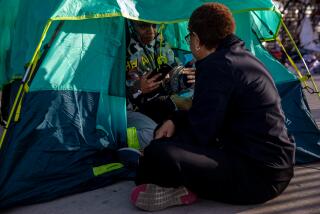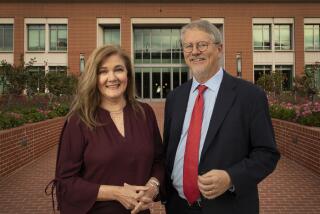Editorial: Mayor Garcetti sets another ambitious goal on homelessness. Great. This time we need him to keep it
Declaring that Los Angeles can effectively end homelessness within 10 years was an audacious move by Mayor Eric Garcetti. “Foolhardy” might be just as apt a description.
After all, Garcetti has a track record of setting goals and not achieving them. Spurred by the Obama administration’s nationwide challenge, the mayor vowed in 2014 to end homelessness among veterans by the end of 2015, but failed to do so — even after extending his own deadline to 2016. (The number went from 2,733 in 2015 down to 1,617 in 2016, then back up to 2,518 last year.) Before that, when he was running for mayor in 2013, he vowed to end chronic homelessness. That population is the most entrenched and most vulnerable. Obviously, that didn’t happen.
And, not to pile on, but homelessness isn’t the only issue he has tried unsuccessfully to tackle with a numerical target. He created the Vision Zero initiative in 2015 to try to reduce traffic deaths on city streets by 20% in 2017 and to zero in 2025. But traffic deaths went down only 6% in those first two years, with pedestrian deaths actually going up more than 80%.
Now, he has tasked himself and his successors with an even bigger lift on homelessness. According to the official 2017 point-in-time count, a total of 34,189 people were homeless in the city, including about 9,000 who spend nights in shelters. Of the 25,237 unsheltered, Garcetti says he’s aiming to get half off the streets by 2022, then reach the functional equivalent of zero homelessness by 2028.
Angelenos need not just to hold Garcetti and the mayors who come after him to account, but also must become part of the solution themselves.
He’s not the first elected leader in the vicinity to announce a deadline for ending homelessness. In 2003, then-Mayor James Hahn announced the creation of an illustrious panel of civic and elected leaders to end homelessness in a decade. In fact, Garcetti, a council member at the time, was on it. The next mayor, Antonio Villaraigosa, became part of the panel; Villaraigosa later led his own effort to solve homelessness.
So we’ve been this way before.
The L.A. City Council got into the act too, pledging Tuesday that each member would back the approval of at least 222 units of supportive housing for homeless people in his or her district by July 2020. That’s a more achievable goal, it’s still a challenge.
We’re journalists. No one busts deadlines more than we do. But this deadline of Garcetti’s is different — it’s about ending a humanitarian crisis. Failing to meet it will be costly in every way.
There’s also something galvanizing about challenging a community to fix its biggest problem, no matter how difficult. And we fear for a society where leaders aren’t willing to risk their reputations and political futures to solve a crisis like this one. We need elected officials with determination and courage to tackle homelessness. Will Garcetti be that kind of leader? We hope that he takes this goal as seriously as we do.
One thing on Garcetti’s side this time around is the infusion of funding for housing and services from Proposition HHH and the county’s Measure H. Another change is that the city’s residents now realize how severe and intractable the problem of homelessness is. They simply can’t avoid it — homeless people live in all neighborhoods.
Angelenos need not just to hold Garcetti and the mayors who come after him to account, but also must become part of the solution themselves. Let’s see housing — both temporary and permanent — come online faster, aided by more community support. Let’s have the mayor report on the city’s progress every few months. There’s no point in waiting until 2022 to ask whether Garcetti’s goal was a pipe dream.
And for Garcetti’s part, he will need to marshal all his political will and capital for this issue for as long as he’s still serving. That means going to neighborhoods and telling people why they should stop fighting the proposed housing development for 60 homeless people down the block, why the development can’t be moved to another neighborhood and why the number of residents can’t be dropped to five. We can have homeless people on our streets or we can have them in apartment buildings down the street. Those are the choices. They are not going to be bused to the Antelope Valley or Arizona or any other place Los Angeles residents think would be better than their own neighborhoods.
The more of us who embrace the goal Garcetti has laid out, the better chance we’ll have of reaching it. This movement needs a leader, but also a city that will follow.
Follow the Opinion section on Twitter @latimesopinion or Facebook
More to Read
A cure for the common opinion
Get thought-provoking perspectives with our weekly newsletter.
You may occasionally receive promotional content from the Los Angeles Times.






